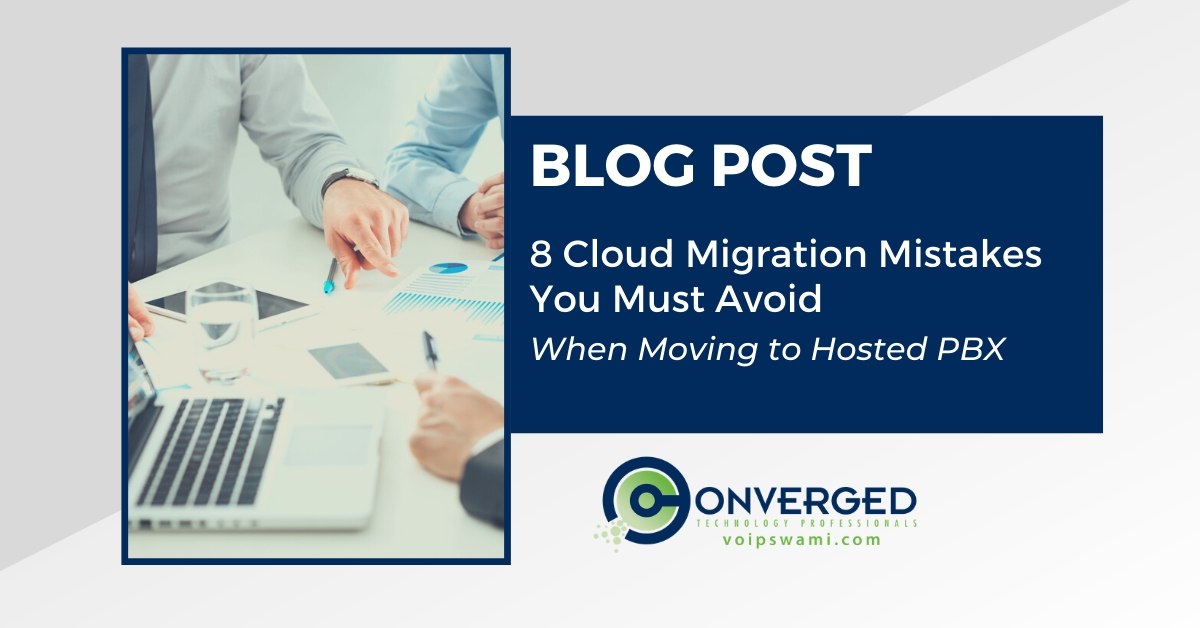
Data centers and legacy solutions continue their migration from on-prem and into the cloud. If you haven't thought about it yet, it's time to think about bravely letting go of your trusted onsite PBX.
Moving your telephony to the cloud sounds simple enough in a meeting room, but without adequate planning, you could make unnecessary migration mistakes as you embark on a needlessly stressful journey.
A lack of preparation, guidance, and due diligence can cause migrations to encounter costly setbacks. However, by preparing yourself with the right information and support partner, it can be an incredibly positive experience that results in celebrating a hugely successful project.
A study by Walker revealed that by 2020, the customer experience would overtake price and product as the key brand differentiator. The customization and programming options that come with new cloud-based systems will enable you to configure existing features while also adding new ones too.
But where do you begin?
You know the reasons why you need to make your telephony system fit for a digital age. But here are 8 mistakes to avoid that will save you time, money, stress, delays, and unwanted surprises.
1. Assuming the Hosted Solution will be a Mirror Image of your PBX solution
It's often said that the most dangerous phrase to businesses in a digital age is, "But, we've always done it this way."
Although moving to the cloud will present an opportunity for more efficient ways of working, do not underestimate the need to invest time into your corporate culture as well as new technology.
Please do not make the mistake of thinking that every department will retain its current features, functionality, and quirky working methods. Everyone will need to feel a part of the journey and understand how they can conform to the newly available options.
But also accept that there will be limitations that will require them to change how they manage their telephony.
2. Not Opting for a Better Disaster Recovery Plan
Traditionally, business leaders have felt safe during an outage by observing a stressed looking IT team entering a mysterious door and fixing the problem.
But the reality is that an on-premises PBX system can and will be negatively affected by issues such as power, weather, water leaks, or an internet outage in your area. Your PBX is typically a single point of failure.
A disaster recovery plan will ensure the service reliability and continuity that your business demands. The harsh reality for businesses and their trusted onsite PBX is that unlike a cloud phone provider, it probably won't have sophisticated dual-powered cooling equipment, independent distribution paths, or built on a fault-tolerant infrastructure.
Although cloud phone systems provide the luxury of having reliability built-in, you still need to explore what disaster recovery plan and SLA's they have in place.
For example, some providers will store your data in multiple locations so it can fall over to an alternative system if there was an issue in the provider's primary data center. But once again, don't assume anything.
3. Expecting IT Staff will Have the Same Level of Control as in the Past
IT staff are the guardians of the company network and will understandably be nervous about losing control of the telephony system. One of the myths is that a business will lose control over everything from administrative functions to ongoing monitoring.
The reality is that admins can have even more useful tools to manage their new cloud-hosted phone communications.
The introduction of customized monitoring allows for proactive changes and real-time adjustments to be made if any issues with the system arise. Sure, the reality is you won't have the same level of control as with an onsite PBX.
However, cloud solutions will help remove unnecessary complexities and simplify the system, which will ultimately be better for everyone in your company.
4. Lack of Communication Between Migration Team and End Users

Imagine being told by IT that the phone systems will switch over on Monday, but there is nothing to worry about. However, when Monday arrives, an entire team is faced with a new system that is unfamiliar to them.
To further add to their pain, they suddenly feel helpless upon the discovery that their speed dials, contact lists, greetings, voicemails, and call handling rules have all disappeared.
Frustration will quickly turn to anger at a time where you need buy-in from every employee. At the heart of a PBX to cloud migration is communication. Investing project resources into educating and training teams will help build confidence and help them customize their setups. Ongoing training should also continue after the go-live to ensure that users do not feel abandoned.
One of the biggest mistakes that many companies make is not talking to the users of the system and asking the right questions. By simply asking at the beginning of your journey, what would you do differently? Or what would make your life easier? You can begin to build a system that works and provides value to everyone.
By bringing every employee along for the ride, they can learn how to improve how they manage their calls and retire legacy methods that are no longer fit for purpose. Every employee will be asking, what's in it for me?
Educating staff about how it can make their lives easier and encourage greater efficiency is a step that is crucial to the success of your project.
5. Neglecting Proper Analysis of Your Bandwidth
Much has changed in the workplace since the original implementation of your now-aging PBX. The rise of remote working and online collaboration means that video conferencing will be equally as important if not more so than traditional phone calls.
If you fail to plan, you plan to fail. Without proper analysis of your bandwidth, you won't know if it can handle more than voice.
Before even thinking about migrating to the cloud, you will need to determine if you have a fast and reliable fiber connection. Your connection will need to be capable of handling and a continuously increasing amount of bandwidth.
Your cloud solution will eventually begin displacing other analog devices with everything from elevators to fax machines being thrown into the mix. As video conferencing calls with 25 employees become the norm, you need to ensure your bandwidth is ready to take the strain.
6. Not Documenting and Analyzing Your List of Network Devices for Compatibility

After years of managing an IT infrastructure that runs on legacy technology, it's time to pay back the technical debt that you have accumulated over the years. You need to identify and understand how every online device will perform in the new cloud environment.
For example, you may find that employee desktops using terminal services can't use the softphones you thought were compatible with your current user configurations.
Ideally, this identification process would be managed by both your IT department and a support partner. By working together, they will help avoid any embarrassing discoveries further on down the line.
7. Forgetting About your Existing Contracts and Compliance
Your current setup could involve a contract with a primary rate interface (PRI) or session initiation protocol (SIP) company. You will need to check your existing contracts and identify any potential early termination fees.
If you fail to discover this critical information until the final hour, it could result in embarrassing and frustrating delays to the migration project timeframe.
Compliance is another subject that needs to be treated with respect. Is your system HIPAA SOC 2 and 3 Compliant? If these questions leave you feeling a little uneasy, then you will need another information discovery exercise to help you determine where you are now and what you need to do next to ensure you are compliant.
8. Trying to Do Everything on Your Own
How many PBX to cloud migrations have you managed over the last ten years? In this fast-moving industry that is continually evolving, you can dramatically improve your chances of success by bringing a support partner that has vast experience delivering similar projects.
Rather than making unnecessary mistakes, you can leverage the insights of those that have seen it all before. An experienced support partner should be familiar with the solution you're moving to, as well as able to identify the best practices and areas you may not have thought of.
However, before you dive in headfirst and begin your cloud migration, we can help you be better prepared. If you would like a quick conversation about your plans and would like to know your options, please contact us today.
If you enjoyed this article, you'll also enjoy:

Converged Technology Professionals is a RingCentral Premier Partner and a Mitel Platinum partner experienced in helping businesses migrate their office and contact center operations and infrastructure to the cloud. Converged has offices in Milwaukee, Crystal Lake, Illinois, Indianapolis, and the Grand Rapids area.